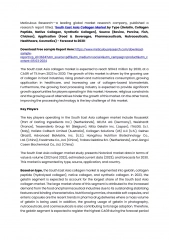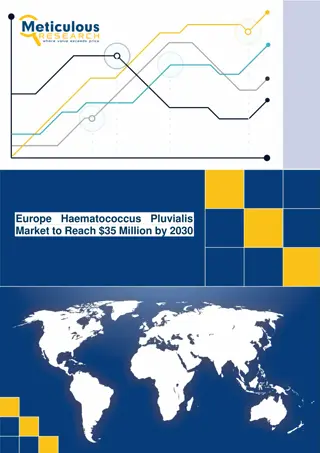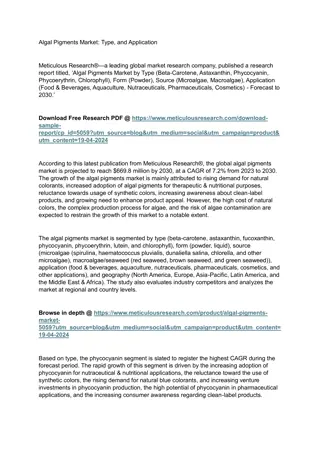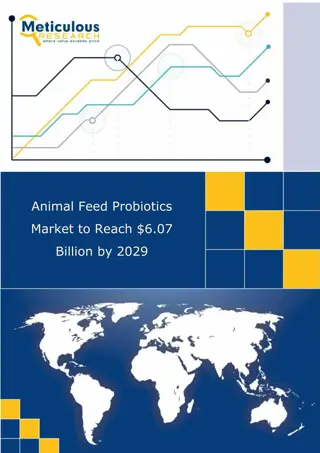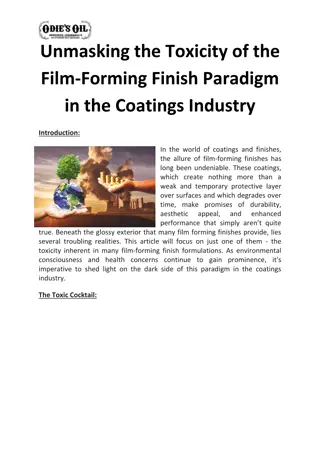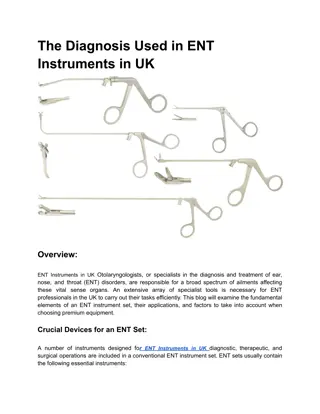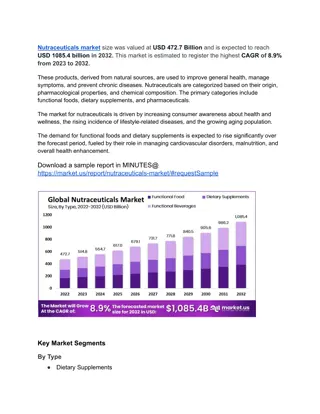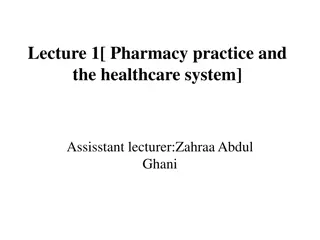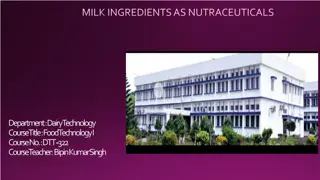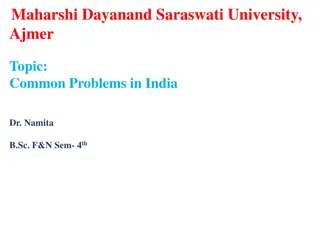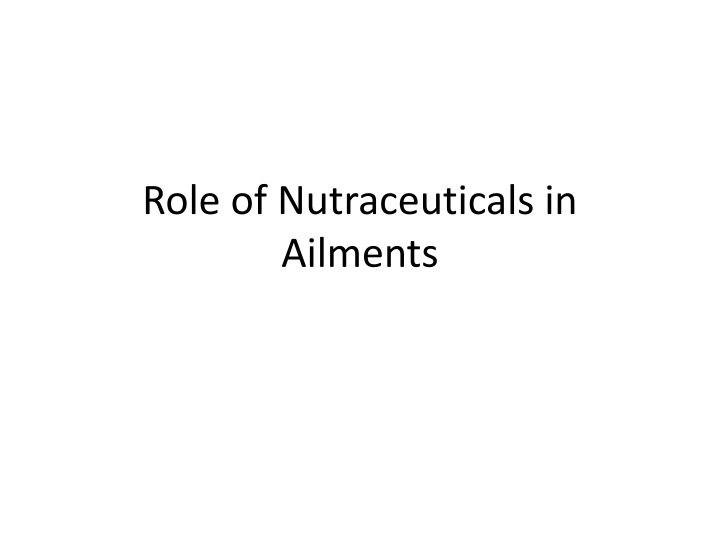
Role of Nutraceuticals in Combatting Cancer: Mechanisms, Phytochemicals, and Vitamins
Discover the significant role of nutraceuticals in cancer prevention and treatment, including their mechanisms of action, impact on reducing drug toxicity, and efficacy against various cancer types. Learn about phytochemicals such as curcumin and flavonoids, as well as essential vitamins and minerals that play a crucial role in fighting cancer.
Download Presentation

Please find below an Image/Link to download the presentation.
The content on the website is provided AS IS for your information and personal use only. It may not be sold, licensed, or shared on other websites without obtaining consent from the author. If you encounter any issues during the download, it is possible that the publisher has removed the file from their server.
You are allowed to download the files provided on this website for personal or commercial use, subject to the condition that they are used lawfully. All files are the property of their respective owners.
The content on the website is provided AS IS for your information and personal use only. It may not be sold, licensed, or shared on other websites without obtaining consent from the author.
E N D
Presentation Transcript
Role of Nutraceuticals in Ailments
Role of nutraceutical in Cancer: Major expectancy, change in life style and diet pattern. As per research 1/3rdof all cancer death can be prevented by change in life style including diet. Cancer treatment in nutraceutical having chemo preventive effects can be employed. Chemopreventive means the substances which are used to prevent, suppress or reduce the process of carcinoginosis. health problem due to enhanced very expensive so
. Nutraceuticals also helpful in reducing toxicity of drugs, chemotherapy, radiation and assist to live better life. Research reported that use of carotene rich food, vit. E,C and many more comp. in food benefit to fight cancer. Several studies shows that phytoconstituents (turmeric), capsacin, gingerol, genistein 9soya bean) lycopene, emodin, anetole, quercetin have anticancer activity. as curcumin (garpes), resveratol
Mecahnism of action of nutraceutical against cancer Act by different mechanism and may have overall synergy effect. Nutraceuticals act as inflammatory. They inhibit the signaling pathway related to redox mediated transcription factors. Some nutraceuticals like ascorbic acid, tocopherol, phenols are inhibitors of carcinogen formation. They protect against lipid peroxidation. They suppress mutagenic activity of carcinogens, suppress cell proliferation and induce cancer cell apoptosis. antioxidant and anti-
Phytochemical effective against cancer: compound: They carcinogenesis process and supress progression of cancer. Eq. Epigallocatechin: present in green tea, have antitumor properties. Resveratrol: It is used in treatment of cancer because 9f its antiproliferative action. Present in grapes, Blueberries, peanuts. Flavonoid: It can affect the mRNA level of genes important in cell cycle controll and apoptosis. Some favonoid like genistien modulate topoisomerase II activity. It has strong estrogen agonist activity and inhibit growth activity of breast cancer cells. Curcumin: Chemopreventive in nature. It act as antineoplastic agent causing cell cycle arrest and induces apoptotic signals. Polyphenoic act by inhibition of
. Vitamins and mineral: Vitamin A, C, E and trace elements like selenium can prevent cancer. Ascorbic acid is reported to induce apoptosis through cell cycle arrest. Appropriate dose of supplements like vit. C, E and zinc, calcium reduces the chance of thyroid, bladder and breast cancer. capsacin: Use in treatment of ovarian carcinoma. It inhibit growth and induces apoptosis of cancer cells. lycopene: It inhibit proliferation of cells, use in t/t of prostate , gastric and lung cancer. Chestnut: Antioxidant in nature, used to treat gastric and mild prostate cancer. Ginseng: Used to treat various cancer such as colon, liver, lung and breast being antioxidant in nature.
. Phenols have been shown to reduce cholesterol levels and LDL oxidation. cathechin which is present in Green tea (Camellia sinensis) reduces enhancing antioxidant activity by improving endothelial dysfunction, preventing cardiac hypertrophy and protects mitochondria. Oxyphyte is now a days available products of polyphenolic extracts of green tea, apple, pomegranate and red grape Polyphenolic the CVD by
. Tocotrienols Tocotrienols are members of a subgroup of the vitamin E family, which includes tocopherols. Both tocotrienols and tocopherols are antioxidants, but only tocotrienols have been shown to reduce cholesterol, inhibit certain cancers and manage diabetes. The positive effects of tocotrienols on cholesterol levels result from their ability to down-regulate a liver enzyme involved in cholesterol synthesis i.e. 3- hydroxy- 3methyl-glutaryl-CoA (HMG-CoA reductase). This down- regulation results in a suppression of the activity of the enzyme. Sources: Annatto, Palm oil, cereal grain and rice bran.
Role of nutraceutical in Diabetes : Diabetes is a metabolic syndrome where a person suffers from high blood glucose. It is caused due to lack of insulin production or the body cells do not respond properly to insulin or both. The most common forms of diabetes are type 1 diabetes (5%), an autoimmune disorder, and type 2 diabetes (95%).
. Nutraceutical roles Omega-3 fatty acids have been suggested to reduce glucose tolerance in diabetes. Lipoic acid is a universal antioxidant, now used in Germany for the treatment of diabetic neuropathy. It is possible that lipoic acid may be more effective as a long-term dietary supplement aimed at the prophylactic protection complications. Dietary fibers from psyllium have been used extensively both as pharmacological supplements, food ingredients, in processed food to aid weight reduction, for glucose control in diabetic patients and to reduce lipid levels in hyperlipidemia. patients predisposed to of diabetics from
. - Lipoic acid increases insulin sensitivity by approximately 18 20% in patients with type 2 diabetes mellitus. Phytoestrogens are structurally similar to estradiol and mimic its effects. In animal studies, soy and phytoestrogens are effective at reducing adipose tissue and improving glucose uptake. Chromium supplements sensitivity and improve glucose tolerance in patients with type 2 diabetes mellitus may increase insulin
. Good magnesium status reduces diabetes risk and improves insulin sensitivity; chromium picolinate, calcium and vitamin D appear to promote insulin sensitivity and improve glycemic control in diabeties. Extracts of bitter melon and of cinnamon have the potential to treat and possibly prevent diabetes. Emblica officinalis, fenugreek, green tea anti-oxidant vitamins like vitamin C and E are act by affecting insulin sensitivity and also prevent insulin resistance.

